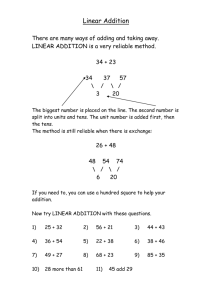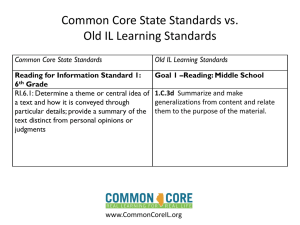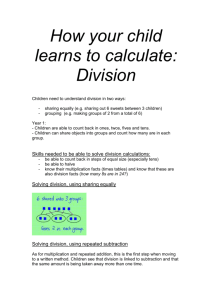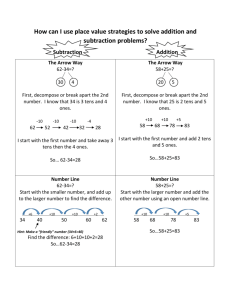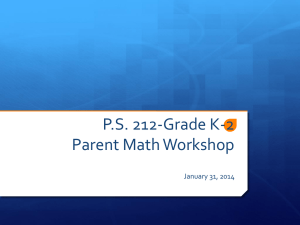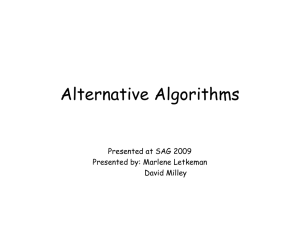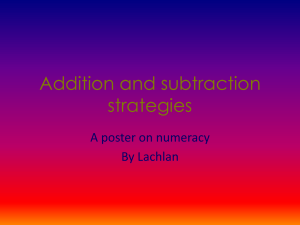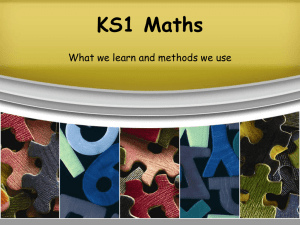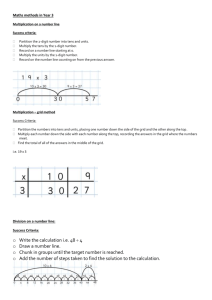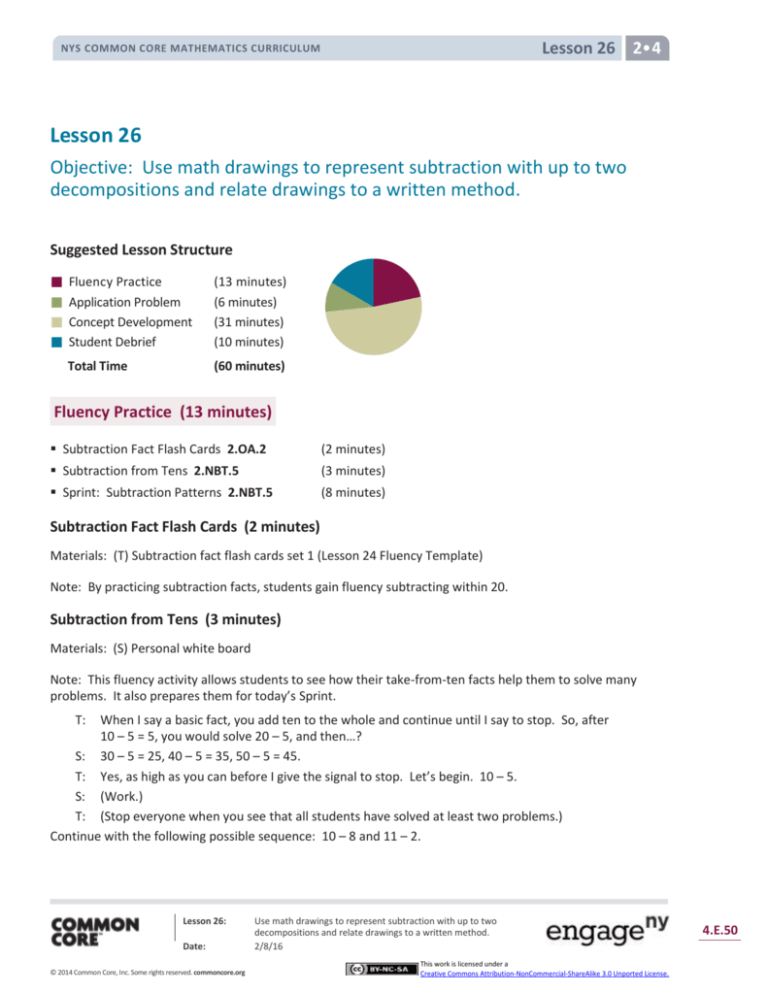
Lesson 26 2•4
NYS COMMON CORE MATHEMATICS CURRICULUM
Lesson 26
Objective: Use math drawings to represent subtraction with up to two
decompositions and relate drawings to a written method.
Suggested Lesson Structure
Fluency Practice
Application Problem
Concept Development
Student Debrief
Total Time
(13 minutes)
(6 minutes)
(31 minutes)
(10 minutes)
(60 minutes)
Fluency Practice (13 minutes)
Subtraction Fact Flash Cards 2.OA.2
(2 minutes)
Subtraction from Tens 2.NBT.5
(3 minutes)
Sprint: Subtraction Patterns 2.NBT.5
(8 minutes)
Subtraction Fact Flash Cards (2 minutes)
Materials: (T) Subtraction fact flash cards set 1 (Lesson 24 Fluency Template)
Note: By practicing subtraction facts, students gain fluency subtracting within 20.
Subtraction from Tens (3 minutes)
Materials: (S) Personal white board
Note: This fluency activity allows students to see how their take-from-ten facts help them to solve many
problems. It also prepares them for today’s Sprint.
T:
When I say a basic fact, you add ten to the whole and continue until I say to stop. So, after
10 – 5 = 5, you would solve 20 – 5, and then…?
S: 30 – 5 = 25, 40 – 5 = 35, 50 – 5 = 45.
T: Yes, as high as you can before I give the signal to stop. Let’s begin. 10 – 5.
S: (Work.)
T: (Stop everyone when you see that all students have solved at least two problems.)
Continue with the following possible sequence: 10 – 8 and 11 – 2.
Lesson 26:
Date:
© 2014 Common Core, Inc. Some rights reserved. commoncore.org
Use math drawings to represent subtraction with up to two
decompositions and relate drawings to a written method.
2/8/16
This work is licensed under a
Creative Commons Attribution-NonCommercial-ShareAlike 3.0 Unported License.
4.E.50
Lesson 26 2•4
NYS COMMON CORE MATHEMATICS CURRICULUM
Sprint: Subtraction Patterns (8 minutes)
Materials: (S) Subtraction Patterns Sprint
Note: Students are given the opportunity to use mental math strategies when crossing tens to subtract.
Application Problem (6 minutes)
Chloe needs 153 beads to make a bag. She only has 49.
How many more beads does she need?
Note: This Application Problem serves as practice of
Lesson 25’s Concept Development.
Concept Development (31 minutes)
Materials: (S) Personal white board
Problem 1: 172 – 56
T:
S:
T:
MP.6
S:
T:
T:
S:
T:
S:
(Write 172 – 56 in vertical form on the board.) Turn
and talk. Use place value language to tell your partner
how you could show this problem with a chip model.
Draw 1 chip in the hundreds, 7 chips in the tens, and
2 chips in the ones. I know that you only show the
whole, so I would show 1 hundred, 7 tens, and 2 ones
by drawing chips in the correct columns on my chart.
(Create a chip model to solve 172 – 56. Remind
students that when subtracting, we only draw the
whole.) Let’s record our work in writing as we solve.
When we are subtracting, what should we always do
first?
Set up the problem for subtraction. Make sure we
have enough ones and tens to solve. Get ready to
subtract.
Yes. Let’s draw our magnifying glass to help us do that.
Can we subtract 6 ones from 2 ones?
No! We need to unbundle a ten.
Could I get the ones I need from the hundred?
No, just tens. Yes, you can. Hey, can we unbundle
the hundred instead? Do you want 100 chips?
That’s not easy. Let’s just change 1 ten for 10 ones.
Lesson 26:
Date:
© 2014 Common Core, Inc. Some rights reserved. commoncore.org
NOTES ON
MULTIPLE MEANS
OF REPRESENTATION:
Engage struggling students with
technology. If you have access to iPads
or other tablets, use an app such as
Number Pieces to represent the
problem with manipulatives that can
be unbundled.
Use math drawings to represent subtraction with up to two
decompositions and relate drawings to a written method.
2/8/16
This work is licensed under a
Creative Commons Attribution-NonCommercial-ShareAlike 3.0 Unported License.
4.E.51
Lesson 26 2•4
NYS COMMON CORE MATHEMATICS CURRICULUM
T:
T:
T:
S:
T:
S:
T:
S:
T:
S:
T:
MP.6
S:
T:
S:
T:
S:
Yes, changing 1 ten for 10 ones is a lot simpler; though, I like that you realize there are ones inside
the hundred, too.
(Cross out a chip in the tens place, adding 10 chips to the ones
place. Record the change on the problem.)
Can we subtract 5 tens from 6 tens?
Yes!
Are we ready to subtract?
Yes!
What is 12 ones minus 6 ones?
(Cross out 6 chips in the ones column on the chip model.)
6 ones.
(Record the ones on the problem.)
What is 6 tens minus 5 tens? (Cross out 5 chips in the tens
place on the chip model.)
1 ten.
(Record the tens on the problem.)
What is 1 hundred minus 0 hundreds?
1 hundred.
Read the answer the Say Ten way.
11 tens 6.
The regular way?
One hundred sixteen.
Problem 2: 137 – 45
T:
S:
T:
S:
T:
S:
T:
S:
T:
This time, you do what I do. (Write 137 – 45 on the
NOTES ON
board in vertical form as students do the same on their
MULTIPLE MEANS
personal white boards. Ask students to leave space on
the left for a place value chart. Draw a chip model to
OF ACTION AND
represent 137 – 45 as students do the same.) What
EXPRESSION:
should we do first with our written numbers?
Some students may be able to go
directly from the previous lesson with
Set up the problem for subtraction. Make sure we
concrete models to the vertical written
have enough ones and tens to subtract.
method. Allow those students to
Can we subtract 5 ones from 7 ones?
demonstrate proficiency with the chip
Yes!
model in the first few problems of the
Problem Set and then continue without
Are we ready to subtract in the ones?
drawing. Have them write challenging
Yes!
problems for each other to solve, after
Can we subtract 4 tens from 3 tens?
solving them first, if they finish early.
No! Unbundle the hundred.
(Cross out the chip in the hundreds place, adding 10 chips to the tens place. Record the change on
the problem. Instruct students to do the same.) Are we ready to subtract in the tens?
Lesson 26:
Date:
© 2014 Common Core, Inc. Some rights reserved. commoncore.org
Use math drawings to represent subtraction with up to two
decompositions and relate drawings to a written method.
2/8/16
This work is licensed under a
Creative Commons Attribution-NonCommercial-ShareAlike 3.0 Unported License.
4.E.52
Lesson 26 2•4
NYS COMMON CORE MATHEMATICS CURRICULUM
S:
T:
S:
T:
MP.6
S:
T:
S:
T:
S:
Yes!
Let’s begin. What is 7 ones minus 5 ones? (Cross out 5
chips in the ones place on the chip model as students
do the same.)
2 ones.
Let’s record that using the algorithm. (Write 2 in the
ones place as students do the same.) What is 13 tens
minus 4 tens? (Cross out 4 chips in the tens place on
the chip model as students do the same.)
9 tens.
Let’s record that on the problem. (Write 9 in the tens
place as students do the same.) What is 137 – 45?
92.
The Say Ten way?
9 ten 2.
Repeat the above process with 112–75. If students show proficiency, allow them to move on to the Problem
Set. Those who need more support might be guided through the following sequence: 127–19, 116–36, and
123–86.
Problem Set (10 minutes)
Students should do their personal best to complete the
Problem Set within the allotted 10 minutes. For some
classes, it may be appropriate to modify the assignment
by specifying which problems they work on first. Some
problems do not specify a method for solving. Students
should solve these problems using the RDW approach
used for Application Problems.
Student Debrief (10 minutes)
Lesson Objective: Use math drawings to represent
subtraction with up to two decompositions and relate
drawings to a written method.
The Student Debrief is intended to invite reflection and
active processing of the total lesson experience.
Invite students to review their solutions for the Problem
Set. They should check work by comparing answers with a
partner before going over answers as a class. Look for
misconceptions or misunderstandings that can be
addressed in the Debrief. Guide students in a
conversation to debrief the Problem Set and process the lesson.
Lesson 26:
Date:
© 2014 Common Core, Inc. Some rights reserved. commoncore.org
Use math drawings to represent subtraction with up to two
decompositions and relate drawings to a written method.
2/8/16
This work is licensed under a
Creative Commons Attribution-NonCommercial-ShareAlike 3.0 Unported License.
4.E.53
Lesson 26 2•4
NYS COMMON CORE MATHEMATICS CURRICULUM
You may choose to use any combination of the questions below to lead the discussion.
Explain to your partner how you solved
Problem 1, Parts (a) and (b). Compare the
unbundling you had to do for each of these
problems. How was it different and how was it
the same?
For Problem 1, Part (c), use place value language
to explain to your partner how your chip model
matches the algorithm. Could you have used a
mental strategy to solve, too?
How does Problem 1, Part (e) help you
understand that 110 is the same as 10 tens and
10 ones?
For Problem 2, explain to your partner whose
drawing was incorrect and why. Use place value
language to defend your reasoning.
Exit Ticket (3 minutes)
After the Student Debrief, instruct students to complete
the Exit Ticket. A review of their work will help you assess
the students’ understanding of the concepts presented in
the lesson today and plan more effectively for future
lessons. You may read the questions aloud to the
students.
Lesson 26:
Date:
© 2014 Common Core, Inc. Some rights reserved. commoncore.org
Use math drawings to represent subtraction with up to two
decompositions and relate drawings to a written method.
2/8/16
This work is licensed under a
Creative Commons Attribution-NonCommercial-ShareAlike 3.0 Unported License.
4.E.54
NYS COMMON CORE MATHEMATICS CURRICULUM
Lesson 26:
Date:
© 2014 Common Core, Inc. Some rights reserved. commoncore.org
Lesson 26 Sprint 2•4
Use math drawings to represent subtraction with up to two
decompositions and relate drawings to a written method.
2/8/16
This work is licensed under a
Creative Commons Attribution-NonCommercial-ShareAlike 3.0 Unported License.
4.E.55
NYS COMMON CORE MATHEMATICS CURRICULUM
Lesson 26:
Date:
© 2014 Common Core, Inc. Some rights reserved. commoncore.org
Lesson 26 Sprint 2•4
Use math drawings to represent subtraction with up to two
decompositions and relate drawings to a written method.
2/8/16
This work is licensed under a
Creative Commons Attribution-NonCommercial-ShareAlike 3.0 Unported License.
4.E.56
Lesson 26 Problem Set 2•4
NYS COMMON CORE MATHEMATICS CURRICULUM
Name
Date
1. Solve vertically. Draw chips on the place value chart. Unbundle when needed.
a. 181 63 = _________
hundreds
tens
ones
b. 134 52 = _________
hundreds
tens
ones
c. 175 79 = _________
hundreds
tens
ones
Lesson 26:
Date:
© 2014 Common Core, Inc. Some rights reserved. commoncore.org
Use math drawings to represent subtraction with up to two
decompositions and relate drawings to a written method.
2/8/16
This work is licensed under a
Creative Commons Attribution-NonCommercial-ShareAlike 3.0 Unported License.
4.E.57
Lesson 26 Problem Set 2•4
NYS COMMON CORE MATHEMATICS CURRICULUM
d. 115 26 = _________
hundreds
tens
ones
e. 110 74 = _________
hundreds
tens
ones
2. Tanisha and James drew models on their place value charts to solve this problem:
102 47. Tell whose model is incorrect and why.
James
Tanisha
_______________’s model is incorrect because __________________________
______________________________________________________________.
Lesson 26:
Date:
© 2014 Common Core, Inc. Some rights reserved. commoncore.org
Use math drawings to represent subtraction with up to two
decompositions and relate drawings to a written method.
2/8/16
This work is licensed under a
Creative Commons Attribution-NonCommercial-ShareAlike 3.0 Unported License.
4.E.58
Lesson 26 Exit Ticket 2•4
NYS COMMON CORE MATHEMATICS CURRICULUM
Name
Date
Solve vertically. Draw chips on the place value chart. Unbundle when needed.
1. 153 46 = _________
hundreds
tens
ones
2. 118 79 = _________
hundreds
tens
ones
Lesson 26:
Date:
© 2014 Common Core, Inc. Some rights reserved. commoncore.org
Use math drawings to represent subtraction with up to two
decompositions and relate drawings to a written method.
2/8/16
This work is licensed under a
Creative Commons Attribution-NonCommercial-ShareAlike 3.0 Unported License.
4.E.59
Lesson 26 Homework 2•4
NYS COMMON CORE MATHEMATICS CURRICULUM
Name
Date
1. Solve vertically. Draw chips on the place value chart. Unbundle when needed.
a. 114 65 = _________
hundreds
tens
ones
b. 120 37 = _________
hundreds
tens
ones
c. 141 89 = _________
hundreds
tens
ones
Lesson 26:
Date:
© 2014 Common Core, Inc. Some rights reserved. commoncore.org
Use math drawings to represent subtraction with up to two
decompositions and relate drawings to a written method.
2/8/16
This work is licensed under a
Creative Commons Attribution-NonCommercial-ShareAlike 3.0 Unported License.
4.E.60
Lesson 26 Homework 2•4
NYS COMMON CORE MATHEMATICS CURRICULUM
d. 136 77 = _________
hundreds
tens
ones
e. 154 96 = _________
hundreds
tens
ones
2. Extension: Fill in the missing number to complete the problem. Draw a place value
chart and chips to model.
1 2 3
5
6 9
Lesson 26:
Date:
© 2014 Common Core, Inc. Some rights reserved. commoncore.org
Use math drawings to represent subtraction with up to two
decompositions and relate drawings to a written method.
2/8/16
This work is licensed under a
Creative Commons Attribution-NonCommercial-ShareAlike 3.0 Unported License.
4.E.61

